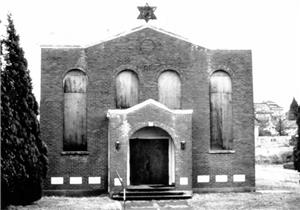Congregation Machzikay Hadath (Jewish) was incorporated on March 11, 1930. Its origin was the vote to modernize Herzl (Jewish) Congregation, which prompted a dissenting group to form a new congregation.
With this vote to modernize, Rabbi Baruch Shapiro resigned as spiritual leader of Herzl. A group of the Rabbi's loyal followers, also opposed to modernization, founded Congregation Machzikay Hadath. The meaning of the Hebrew words is "strengtheners, supporters and promoters of the religion." Machzikay Hadath was founded to be "more strictly orthodox than any congregation in the city."
Spiritual Leadership
Rabbi Baruch Shapiro was the spiritual leader of Machzikay Hadath for almost 40 years. Born in Szmorgan, Lithuania, Rabbi Shapiro was a renowned scholar, who had received ordination and studied under some of the great rabbinic scholars of Eastern Europe. Rabbi Shapiro fled Russia in 1905, came to the West Coast in 1913 and married Hilda Gershonovitch in Seattle in 1915. He became rabbi of Herzl in 1923 and rabbi of Congregation Machzikay Hadath at its inception.
The first officers of Congregation Machzikay Hadath were:
- George Rubinchik, president;
- Louis Berolsky, vice president;
- Morris Feinberg, treasurer;
- Isadore Schrieber, secretary.
Members of the committee were:
- A.C. Levinson
- Wolf Rabinowitz
- A. Aronin
- Beryl Bialostotsky
- Sam Gross.
The congregation's first home was the private residence of Beryl Bialostotsky at 122 18th Avenue. Then the Congregation rented a home at 305 19th Avenue. They stayed there until Bialostotsky purchased a home at 155 23th Avenue. The family lived upstairs and the schul (synagogue) was downstairs.
In 1932, Machzikay bought two lots at 26th Avenue and Fir Street. The newly built schul was dedicated on September 17, 1933. Preceding the dedication was a Torah parade led by Rabbi Shapiro, including the children of Seattle Talmud Torah and Sephardic Talmud Torah. At the dedication, Orthodox rabbis from all over the Pacific Northwest gave talks.
Challenges and Changes
In the 1950s, Machzikay Hadath faced financial challenges and in the 1960s, as many Orthodox Jews moved to Seward Park, attendance dwindled. Crime and racial tensions in the Central Area, where the synagogue was situated, had intensified. In 1968, the rabbi was accosted and robbed. He kept his composure, saying, "Gentlemen, gentlemen, no violence, please." Fortunately he was not injured, but the schul closed shortly thereafter.
On October 7, 1979, Machzikay Hadath approved a merger with Bikur Cholim. After 80 years, Bikur Cholim changed its name to Bikur-Cholim-Machzikay-Hadath, thus preserving the memory of Congregation Machzikay Hadath.

